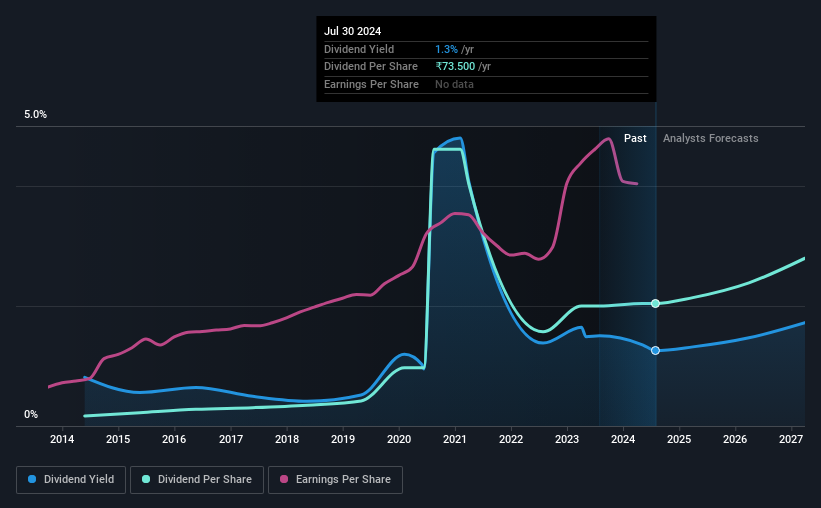Interested In Britannia Industries' (NSE:BRITANNIA) Upcoming ₹73.50 Dividend? You Have Four Days Left

It looks like Britannia Industries Limited (NSE:BRITANNIA) is about to go ex-dividend in the next four days. Typically, the ex-dividend date is one business day before the record date which is the date on which a company determines the shareholders eligible to receive a dividend. The ex-dividend date is an important date to be aware of as any purchase of the stock made on or after this date might mean a late settlement that doesn't show on the record date. In other words, investors can purchase Britannia Industries' shares before the 5th of August in order to be eligible for the dividend, which will be paid on the 10th of September.
The company's next dividend payment will be ₹73.50 per share, on the back of last year when the company paid a total of ₹73.50 to shareholders. Last year's total dividend payments show that Britannia Industries has a trailing yield of 1.3% on the current share price of ₹5842.20. If you buy this business for its dividend, you should have an idea of whether Britannia Industries's dividend is reliable and sustainable. So we need to check whether the dividend payments are covered, and if earnings are growing.
View our latest analysis for Britannia Industries
If a company pays out more in dividends than it earned, then the dividend might become unsustainable - hardly an ideal situation. Its dividend payout ratio is 83% of profit, which means the company is paying out a majority of its earnings. The relatively limited profit reinvestment could slow the rate of future earnings growth. We'd be worried about the risk of a drop in earnings. A useful secondary check can be to evaluate whether Britannia Industries generated enough free cash flow to afford its dividend. Over the last year, it paid out more than three-quarters (86%) of its free cash flow generated, which is fairly high and may be starting to limit reinvestment in the business.
It's positive to see that Britannia Industries's dividend is covered by both profits and cash flow, since this is generally a sign that the dividend is sustainable, and a lower payout ratio usually suggests a greater margin of safety before the dividend gets cut.
Click here to see the company's payout ratio, plus analyst estimates of its future dividends.

Have Earnings And Dividends Been Growing?
Companies with consistently growing earnings per share generally make the best dividend stocks, as they usually find it easier to grow dividends per share. If earnings decline and the company is forced to cut its dividend, investors could watch the value of their investment go up in smoke. Fortunately for readers, Britannia Industries's earnings per share have been growing at 13% a year for the past five years. The company paid out most of its earnings as dividends over the last year, even though business is booming and earnings per share are growing rapidly. We're surprised that management has not elected to reinvest more in the business to accelerate growth further.
Many investors will assess a company's dividend performance by evaluating how much the dividend payments have changed over time. Britannia Industries has delivered an average of 28% per year annual increase in its dividend, based on the past 10 years of dividend payments. It's exciting to see that both earnings and dividends per share have grown rapidly over the past few years.
Final Takeaway
From a dividend perspective, should investors buy or avoid Britannia Industries? It's good to see earnings are growing, since all of the best dividend stocks grow their earnings meaningfully over the long run. However, we'd also note that Britannia Industries is paying out more than half of its earnings and cash flow as profits, which could limit the dividend growth if earnings growth slows. All things considered, we are not particularly enthused about Britannia Industries from a dividend perspective.
So while Britannia Industries looks good from a dividend perspective, it's always worthwhile being up to date with the risks involved in this stock. In terms of investment risks, we've identified 1 warning sign with Britannia Industries and understanding them should be part of your investment process.
Generally, we wouldn't recommend just buying the first dividend stock you see. Here's a curated list of interesting stocks that are strong dividend payers.
If you're looking to trade Britannia Industries, open an account with the lowest-cost platform trusted by professionals, Interactive Brokers.
With clients in over 200 countries and territories, and access to 160 markets, IBKR lets you trade stocks, options, futures, forex, bonds and funds from a single integrated account.
Enjoy no hidden fees, no account minimums, and FX conversion rates as low as 0.03%, far better than what most brokers offer.
Sponsored ContentValuation is complex, but we're here to simplify it.
Discover if Britannia Industries might be undervalued or overvalued with our detailed analysis, featuring fair value estimates, potential risks, dividends, insider trades, and its financial condition.
Access Free AnalysisHave feedback on this article? Concerned about the content? Get in touch with us directly. Alternatively, email editorial-team (at) simplywallst.com.
This article by Simply Wall St is general in nature. We provide commentary based on historical data and analyst forecasts only using an unbiased methodology and our articles are not intended to be financial advice. It does not constitute a recommendation to buy or sell any stock, and does not take account of your objectives, or your financial situation. We aim to bring you long-term focused analysis driven by fundamental data. Note that our analysis may not factor in the latest price-sensitive company announcements or qualitative material. Simply Wall St has no position in any stocks mentioned.
Have feedback on this article? Concerned about the content? Get in touch with us directly. Alternatively, email editorial-team@simplywallst.com
About NSEI:BRITANNIA
Britannia Industries
Manufactures and sells various food products in India and internationally.
Flawless balance sheet established dividend payer.
Similar Companies
Market Insights
Community Narratives




